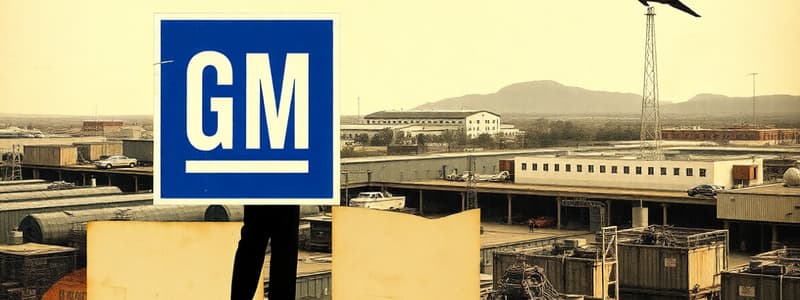Podcast
Questions and Answers
What was a significant issue at the GM Fremont Plant in 1982?
What was a significant issue at the GM Fremont Plant in 1982?
- High employee morale
- Efficient assembly costs
- High number of unresolved grievances (correct)
- Low absenteeism rates
Which strategy did General Motors implement in the 1950s?
Which strategy did General Motors implement in the 1950s?
- Union expansion strategy
- Sunbelt Strategy (correct)
- Globalization Strategy
- Westward Plant Strategy
What was the absentee rate at the NUMMI plant in 1986 compared to the GM Fremont Plant in 1982?
What was the absentee rate at the NUMMI plant in 1986 compared to the GM Fremont Plant in 1982?
- Higher at NUMMI
- Similar to GM Fremont
- Non-existent at NUMMI
- Lower at NUMMI (correct)
Which of the following statements correctly describes the quality of production at the NUMMI plant?
Which of the following statements correctly describes the quality of production at the NUMMI plant?
What crucial need did the new management at NUMMI aim to fulfill?
What crucial need did the new management at NUMMI aim to fulfill?
What do management theories primarily focus on?
What do management theories primarily focus on?
Which characteristic is commonly associated with transformational leaders?
Which characteristic is commonly associated with transformational leaders?
Which of the following best defines relationship theories?
Which of the following best defines relationship theories?
What is a primary outcome of effective leadership in the Diamond Model?
What is a primary outcome of effective leadership in the Diamond Model?
How do managerial theories typically reward employee success?
How do managerial theories typically reward employee success?
Which factor is least likely to influence commitment according to the Diamond Model?
Which factor is least likely to influence commitment according to the Diamond Model?
What is a common tool used to manage change within organizations?
What is a common tool used to manage change within organizations?
What is the primary focus of relationship theories in leadership?
What is the primary focus of relationship theories in leadership?
What is the main goal of the competition announced by Top Management?
What is the main goal of the competition announced by Top Management?
What will the winners of the main competition receive?
What will the winners of the main competition receive?
What additional competition is announced alongside the main competition?
What additional competition is announced alongside the main competition?
How long has the manager been overseeing the women’s and men’s departments?
How long has the manager been overseeing the women’s and men’s departments?
How many employees does the manager oversee?
How many employees does the manager oversee?
What is one outcome the manager hopes to achieve by winning the competition?
What is one outcome the manager hopes to achieve by winning the competition?
Where will the first meeting to discuss the competition take place?
Where will the first meeting to discuss the competition take place?
What is the time frame for measuring the sales competition?
What is the time frame for measuring the sales competition?
What is the primary assumption of the Great Man theory regarding leadership?
What is the primary assumption of the Great Man theory regarding leadership?
In which paradigm is power distributed by gender and office?
In which paradigm is power distributed by gender and office?
Which leadership theory focuses on the interaction between leadership styles and the specific circumstances?
Which leadership theory focuses on the interaction between leadership styles and the specific circumstances?
What assumption underlies trait theories of leadership?
What assumption underlies trait theories of leadership?
Which of the following paradigms redistributes power to key process contributors (KPCs)?
Which of the following paradigms redistributes power to key process contributors (KPCs)?
What is a key criticism of the Great Man and Trait theories of leadership?
What is a key criticism of the Great Man and Trait theories of leadership?
Which leadership theory identifies specific personality traits that may contribute to effective leadership?
Which leadership theory identifies specific personality traits that may contribute to effective leadership?
In which era is the leadership structure defined by 'Father knows best' primarily found?
In which era is the leadership structure defined by 'Father knows best' primarily found?
What do contingency theories of leadership emphasize?
What do contingency theories of leadership emphasize?
In which situation would an authoritarian leadership style be most appropriate?
In which situation would an authoritarian leadership style be most appropriate?
Behavioral theories suggest that leadership skills can be developed through:
Behavioral theories suggest that leadership skills can be developed through:
What is the main focus of participative leadership theories?
What is the main focus of participative leadership theories?
How do situational theories of leadership differ from contingency theories?
How do situational theories of leadership differ from contingency theories?
Which of the following statements is true regarding effective leadership?
Which of the following statements is true regarding effective leadership?
What is a characteristic of leaders who utilize a democratic leadership style?
What is a characteristic of leaders who utilize a democratic leadership style?
What does the behavioral theory of leadership reject?
What does the behavioral theory of leadership reject?
What was a notable consequence of the Sunbelt Strategy for General Motors in the 1950s?
What was a notable consequence of the Sunbelt Strategy for General Motors in the 1950s?
In 1986, how did the absenteeism rate at the NUMMI plant compare to that at the GM Fremont Plant in 1982?
In 1986, how did the absenteeism rate at the NUMMI plant compare to that at the GM Fremont Plant in 1982?
Which of the following demonstrates a key difference in grievances between the GM Fremont Plant and NUMMI?
Which of the following demonstrates a key difference in grievances between the GM Fremont Plant and NUMMI?
What was the state of productivity at the NUMMI plant compared to GM's average in 1986?
What was the state of productivity at the NUMMI plant compared to GM's average in 1986?
What crucial management need was addressed by new management at NUMMI?
What crucial management need was addressed by new management at NUMMI?
What is the primary assumption underlying Great Man theories of leadership?
What is the primary assumption underlying Great Man theories of leadership?
Which of the following traits is commonly associated with effective leaders according to trait theories?
Which of the following traits is commonly associated with effective leaders according to trait theories?
In which leadership era is power primarily distributed by gender and lineage?
In which leadership era is power primarily distributed by gender and lineage?
What criticism is commonly leveled against trait theories of leadership?
What criticism is commonly leveled against trait theories of leadership?
Which paradigm facilitates a redistribution of power to key process contributors?
Which paradigm facilitates a redistribution of power to key process contributors?
Which leadership theory suggests that effective leadership can change depending on the specific situation?
Which leadership theory suggests that effective leadership can change depending on the specific situation?
What primary assumption differentiates participative leadership theories from authoritarian styles?
What primary assumption differentiates participative leadership theories from authoritarian styles?
What perspective is crucial to both Great Man and Trait theories regarding the origin of leadership capabilities?
What perspective is crucial to both Great Man and Trait theories regarding the origin of leadership capabilities?
What is the primary focus of management theories?
What is the primary focus of management theories?
Which statement best describes transformational leadership?
Which statement best describes transformational leadership?
In the Diamond Model of Leadership, what is essential for influencing others?
In the Diamond Model of Leadership, what is essential for influencing others?
What do relationship theories primarily seek to achieve?
What do relationship theories primarily seek to achieve?
How do managerial theories typically enforce accountability?
How do managerial theories typically enforce accountability?
Which of the following is least likely to be a factor in developing commitment according to the Diamond Model?
Which of the following is least likely to be a factor in developing commitment according to the Diamond Model?
What characterizes transformational leaders compared to transactional leaders?
What characterizes transformational leaders compared to transactional leaders?
What is an essential element of designing organizational commitment?
What is an essential element of designing organizational commitment?
What is the primary criterion for winning the sales competition among the Women's Departments?
What is the primary criterion for winning the sales competition among the Women's Departments?
What kind of reward will the winners of the main competition receive?
What kind of reward will the winners of the main competition receive?
What additional activity is encouraged through the competition aside from sales progression?
What additional activity is encouraged through the competition aside from sales progression?
How long has the manager been in charge of the women's and men's departments?
How long has the manager been in charge of the women's and men's departments?
What is one of the manager's objectives in winning the competition?
What is one of the manager's objectives in winning the competition?
In what setting will the manager discuss the competition with employees?
In what setting will the manager discuss the competition with employees?
What aspect of the competition will results be measured on a daily basis?
What aspect of the competition will results be measured on a daily basis?
What is the minimum age range of the employees managed by the individual?
What is the minimum age range of the employees managed by the individual?
What is the primary premise of contingency theories of leadership?
What is the primary premise of contingency theories of leadership?
Which leadership style is described as being most appropriate when the leader is the most knowledgeable member of a group?
Which leadership style is described as being most appropriate when the leader is the most knowledgeable member of a group?
What do behavioral theories of leadership emphasize about leaders?
What do behavioral theories of leadership emphasize about leaders?
In participative leadership theories, what is the role of the leader regarding input from others?
In participative leadership theories, what is the role of the leader regarding input from others?
Which statement reflects the essence of situational theories of leadership?
Which statement reflects the essence of situational theories of leadership?
What is a critical criticism of trait theories in leadership?
What is a critical criticism of trait theories in leadership?
According to White and Hodgson, what is essential for truly effective leadership?
According to White and Hodgson, what is essential for truly effective leadership?
What do participative leadership theories aim to achieve with group members?
What do participative leadership theories aim to achieve with group members?
Flashcards
Management Theories
Management Theories
Focus on supervision, organization, and group performance, using rewards and punishments for leadership.
Relationship Theories
Relationship Theories
Focus on leader-follower connections, inspiring members to achieve a greater good.
Transactional Theories
Transactional Theories
Leadership style based on rewarding good performance and punishing poor performance.
Transformational Theories
Transformational Theories
Signup and view all the flashcards
Diamond Model of Leadership
Diamond Model of Leadership
Signup and view all the flashcards
Employee Commitment
Employee Commitment
Signup and view all the flashcards
Strategic Thinking
Strategic Thinking
Signup and view all the flashcards
KIABI Vicenza
KIABI Vicenza
Signup and view all the flashcards
KIABI Women's Department Competition
KIABI Women's Department Competition
Signup and view all the flashcards
Winning Reward
Winning Reward
Signup and view all the flashcards
Side Competition
Side Competition
Signup and view all the flashcards
Competition Timeframe
Competition Timeframe
Signup and view all the flashcards
Employee Motivation
Employee Motivation
Signup and view all the flashcards
Manager's Goal
Manager's Goal
Signup and view all the flashcards
Employee Meeting
Employee Meeting
Signup and view all the flashcards
KIABI Vicenza
KIABI Vicenza
Signup and view all the flashcards
Contingency Theories
Contingency Theories
Signup and view all the flashcards
Situational Theories
Situational Theories
Signup and view all the flashcards
Behavioral Theories
Behavioral Theories
Signup and view all the flashcards
Participative Leadership
Participative Leadership
Signup and view all the flashcards
Effective Leadership
Effective Leadership
Signup and view all the flashcards
GM Sunbelt Strategy
GM Sunbelt Strategy
Signup and view all the flashcards
GM Fremont Plant (1982)
GM Fremont Plant (1982)
Signup and view all the flashcards
NUMMI Plant (1986)
NUMMI Plant (1986)
Signup and view all the flashcards
Employee Needs at NUMMI
Employee Needs at NUMMI
Signup and view all the flashcards
Productivity (GM Fremont vs NUMMI)
Productivity (GM Fremont vs NUMMI)
Signup and view all the flashcards
Quality (GM Fremont vs NUMMI)
Quality (GM Fremont vs NUMMI)
Signup and view all the flashcards
Assembly Costs (GM Fremont vs Japan)
Assembly Costs (GM Fremont vs Japan)
Signup and view all the flashcards
Paradigm Shift in Management
Paradigm Shift in Management
Signup and view all the flashcards
Aristocracy
Aristocracy
Signup and view all the flashcards
Bureaucracy
Bureaucracy
Signup and view all the flashcards
Infocracy
Infocracy
Signup and view all the flashcards
Great Man Theory
Great Man Theory
Signup and view all the flashcards
Trait Theory
Trait Theory
Signup and view all the flashcards
Contingency Theory
Contingency Theory
Signup and view all the flashcards
Situational Leadership
Situational Leadership
Signup and view all the flashcards
Behavioral Theories
Behavioral Theories
Signup and view all the flashcards
Participative Leadership
Participative Leadership
Signup and view all the flashcards
Management Theories
Management Theories
Signup and view all the flashcards
Relationship Leadership
Relationship Leadership
Signup and view all the flashcards
Management Theories
Management Theories
Signup and view all the flashcards
Relationship Theories
Relationship Theories
Signup and view all the flashcards
Diamond Model of Leadership
Diamond Model of Leadership
Signup and view all the flashcards
Employee Commitment
Employee Commitment
Signup and view all the flashcards
KIABI Vicenza Manager
KIABI Vicenza Manager
Signup and view all the flashcards
Increase Employee Commitment
Increase Employee Commitment
Signup and view all the flashcards
KIABI Women's Sales Competition
KIABI Women's Sales Competition
Signup and view all the flashcards
KIABI Vicenza Manager
KIABI Vicenza Manager
Signup and view all the flashcards
Competition Timeframe
Competition Timeframe
Signup and view all the flashcards
Employee Meeting
Employee Meeting
Signup and view all the flashcards
Winning Reward
Winning Reward
Signup and view all the flashcards
Side Competition
Side Competition
Signup and view all the flashcards
Manager's Goal
Manager's Goal
Signup and view all the flashcards
GM Sunbelt Strategy
GM Sunbelt Strategy
Signup and view all the flashcards
GM Fremont Plant (1982)
GM Fremont Plant (1982)
Signup and view all the flashcards
NUMMI Plant (1986)
NUMMI Plant (1986)
Signup and view all the flashcards
Employee Needs (NUMMI)
Employee Needs (NUMMI)
Signup and view all the flashcards
Productivity (GM Fremont vs NUMMI)
Productivity (GM Fremont vs NUMMI)
Signup and view all the flashcards
Quality (GM Fremont vs NUMMI)
Quality (GM Fremont vs NUMMI)
Signup and view all the flashcards
Assembly Costs (GM Fremont vs Japan)
Assembly Costs (GM Fremont vs Japan)
Signup and view all the flashcards
Contingency Theories
Contingency Theories
Signup and view all the flashcards
Situational Theories
Situational Theories
Signup and view all the flashcards
Behavioral Theories
Behavioral Theories
Signup and view all the flashcards
Participative Leadership
Participative Leadership
Signup and view all the flashcards
Effective Leadership
Effective Leadership
Signup and view all the flashcards
Paradigm Shift in Management
Paradigm Shift in Management
Signup and view all the flashcards
Aristocracy
Aristocracy
Signup and view all the flashcards
Bureaucracy
Bureaucracy
Signup and view all the flashcards
Infocracy
Infocracy
Signup and view all the flashcards
Great Man Theory
Great Man Theory
Signup and view all the flashcards
Trait Theory
Trait Theory
Signup and view all the flashcards
Contingency Theory
Contingency Theory
Signup and view all the flashcards
Situational Leadership
Situational Leadership
Signup and view all the flashcards
Behavioral Theories
Behavioral Theories
Signup and view all the flashcards
Participative Leadership
Participative Leadership
Signup and view all the flashcards
Key Process Contributors
Key Process Contributors
Signup and view all the flashcards
Study Notes
Leadership: Session 2
- SKEMA Business School, session on leadership
- Session covered GM leadership problems, a 1982 GM Fremont Plant analysis, a 1986 NUMMI Plant and comparison analysis, and the needs of NUMMI's new management.
GM Leadership Problems
- GM's 1950s strategy included building non-union plants in the U.S. South and West
- This strategy was seen as an attempt to move away from unionized areas
- The new plants had high levels of conflict
The 1982 GM Fremont Plant
- 5000 employees
- 20% absenteeism
- 2000 unresolved grievances
- 5000 total annual grievances
- 3-4 wildcat strikes
- Chevrolet Nova
- Assembly costs were 30% higher than Japan's
- Productivity was the worst in GM
- Quality was the worst in GM
The 1986 GM NUMMI Plant
- 2000 employees
- 2% absenteeism
- 0 unresolved grievances
- 2 total annual grievances
- 0 wildcat strikes
- Chevrolet Nova + Geo Prism
- Assembly costs were the same as Japan's
- Productivity was double the GM average
- Quality was the best in GM
What Needs Did New Management at NUMMI Meet?
- Employee understanding
- Employee value
Paradigm Shifts in Management
- Aristocracy (18th century): Power distributed by gender and lineage, "Father knows best"
- Bureaucracy (19th and 20th centuries): Power distributed by gender and office, "Boss knows best"
- Infocracy (Information Age): Power redistributed to key process contributors (KPCs), "KPCs know best"
Main Leadership Theories
- Great Man
- Trait
- Contingency
- Situational
- Behavioral
- Participative
- Management
- Relationship
Great Man Theory
- Great leaders are born, not made
- Inherent leadership capacity
- Leaders possess charisma, confidence, intelligence, and social skills
Trait Theories
- Leaders inherit certain traits that make them naturally suited for leadership
- Extroversion, self-confidence, and courage are some traits.
Contingency Theories
- Leadership style depends on the situation
- Good leaders can adapt their behaviors based on the needs of followers and the circumstances.
Situational Theories
- Leader's best course of action depends on situation variables
- Authoritarian or democratic styles may be more appropriate, depending on the experience level of the group.
Behavioral Theories
- Leadership is learned, not inherent
- Leaders' actions are important
- People can become leaders through teaching and observation
Participative Leadership
- Leadership style that involves input from others
- Leaders encourage contributions and participation
- Team members feel more committed to the process
Management Theories
- Focus on supervision, organization and group performance
- Rewards and punishments as motivators
Relationship Theories (Transformational Theories)
- Leaders focus on relationships with followers
- Leaders motivate and inspire others by helping them achieve their potential.
- These leaders have high ethical and moral standards
The Diamond Model of Leadership
- Includes leader commitment to strategy, strategic thinking, and developing influence in a model with other factors (including results) as a key outcome
Commitment
- Questions: How can I get commitment from people? or How can I create commitment in employees towards my team or organization?
Kiasbi Vincenza Short Case
- Competition among women's departments, Italy
- Top performer in sales wins free dinner for all staff
- Additional creativity competition: photos of employees
Group Presentations
- Bad presentation characteristics
- Good presentation characteristics discussed in class.
HLBT Method for Communicating
- A method for public, digital presentations, and team communication noted as H.L.B.T.
Studying That Suits You
Use AI to generate personalized quizzes and flashcards to suit your learning preferences.
Related Documents
Description
Explore the leadership challenges faced by GM through an in-depth analysis of the 1982 Fremont Plant and the 1986 NUMMI Plant. This session covers key factors contributing to management issues, absenteeism, grievances, and productivity comparisons. Join us to understand how leadership strategies evolved during this era at GM.




